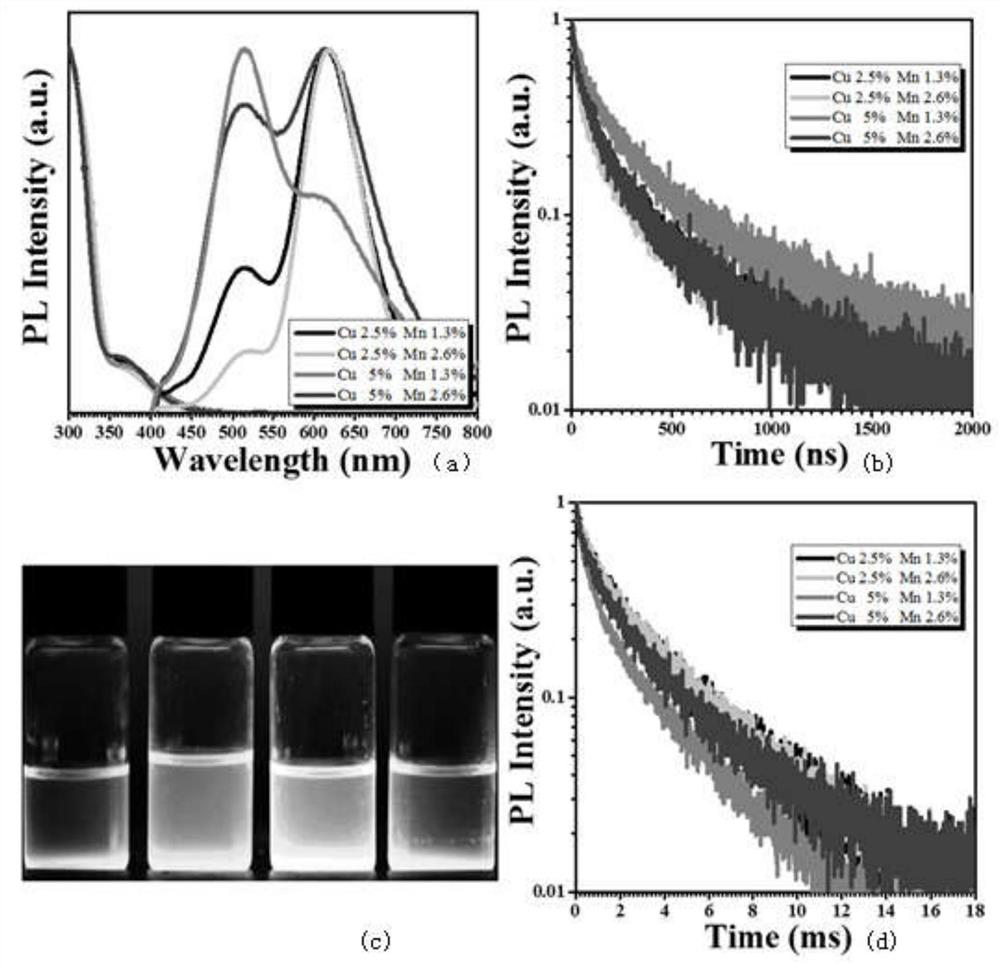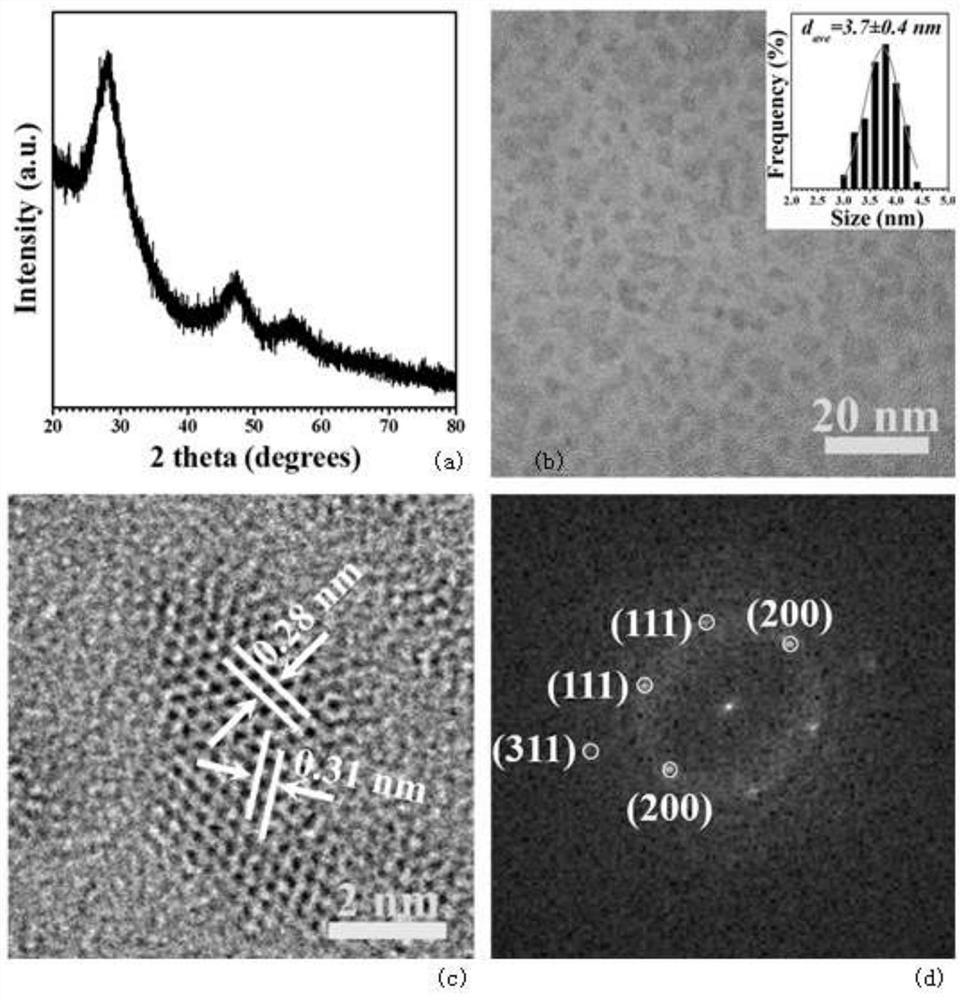A ratiometric temperature sensor based on double-doped quantum dots
A ratio temperature, quantum dot technology, applied in the field of temperature sensors, can solve problems such as changing luminescence performance and temperature sensor failure
- Summary
- Abstract
- Description
- Claims
- Application Information
AI Technical Summary
Problems solved by technology
Method used
Image
Examples
Embodiment 1
[0030] Weigh CuCl (0.01mmol), Mn (OAc) in turn 2 (0.001mmol), In(Ac) 3 (0.2mmol), Zn(Ac) 2 (0.2mmol), DDT (1mL), OLA (1mL) and ODE (5mL) were added to a 100mL three-necked flask. The high-purity argon atmosphere (oxygen-free, the same below) in the bottle is ensured by repeated vacuuming and recirculation of argon. Raise the temperature from room temperature to 100°C for 20 minutes to remove residual water molecules and low-boiling organic matter, and obtain a transparent solution. Then the temperature was raised to 220°C. The sulfur (S) precursor solution (containing 19mg, 0.6mmol S, 1mL ODE and 1mL oleylamine (OLA)) was quickly injected into the three-neck flask, and the growth was maintained at the injection temperature for 20min. At this temperature, 2mL of the zinc precursor solution (containing 0.2mmol zinc acetate (Zn(Ac) 2 ) and 1mL ODE, 1mLOLA) were quickly added to the reaction solution, the temperature was raised to 230°C and kept growing for 20min, and then th...
Embodiment 2
[0034] Weigh CuCl (0.017mmol), Mn (OAc) in turn 2 (0.033mmol), In(Ac) 3 (0.067mmol), Zn(Ac) 2 (0.2mmol), the molar ratio of indium salt to zinc salt is about 1 / 3, DDT (1mL), OLA (1mL) and ODE (5mL) are added in the 100mL three-necked flask. The high-purity argon atmosphere in the bottle is ensured by repeated vacuuming and recirculation of argon. Raise the temperature from room temperature to 95°C for 38 minutes to remove residual water molecules and low-boiling organic matter, and obtain a transparent solution. Then the temperature was raised to 200°C. The sulfur (S) precursor solution (containing 0.1mmol S, 1mL ODE and 1mL oleylamine (OLA)) was quickly injected into the three-neck flask, and the growth was maintained at the injection temperature for 35min. At this temperature, 2mL of the zinc precursor solution ( Contains 0.1mmol zinc acetate (Zn(Ac) 2 ) and 1mL ODE, 1mL OLA) were quickly added to the reaction solution, the temperature was raised to 243°C and kept growi...
Embodiment 3
[0036] Weigh CuCl (0.1mmol), Mn (OAc) in turn 2 (0.062mmol), In(Ac) 3 (0.1mmol), Zn(Ac) 2 (0.2mmol), DDT (1mL), OLA (1mL) and ODE (5mL) were added to a 100mL three-necked flask. The high-purity argon atmosphere in the bottle is ensured by repeated vacuuming and recirculation of argon. Raise the temperature from room temperature to 98°C for 35 minutes to remove residual water molecules and low-boiling organic matter, and obtain a transparent solution. Then the temperature was raised to 240°C. The sulfur (S) precursor solution (containing 1.2mmol S, 1mLODE and 1mL oleylamine (OLA)) was quickly injected into the three-neck flask, and the growth was maintained at the injection temperature for 23min. At this temperature, 2mL of the zinc precursor solution (containing 0.8mmol zinc acetate (Zn(Ac) 2 ) and 1mL ODE, 1mL OLA) were quickly added to the reaction solution, the temperature was raised to 226°C and kept growing for 30min, and then cooled to 124°C. Cu, Mn co-doped Zn-In-...
PUM
| Property | Measurement | Unit |
|---|---|---|
| particle diameter | aaaaa | aaaaa |
Abstract
Description
Claims
Application Information
 Login to View More
Login to View More - R&D Engineer
- R&D Manager
- IP Professional
- Industry Leading Data Capabilities
- Powerful AI technology
- Patent DNA Extraction
Browse by: Latest US Patents, China's latest patents, Technical Efficacy Thesaurus, Application Domain, Technology Topic, Popular Technical Reports.
© 2024 PatSnap. All rights reserved.Legal|Privacy policy|Modern Slavery Act Transparency Statement|Sitemap|About US| Contact US: help@patsnap.com










